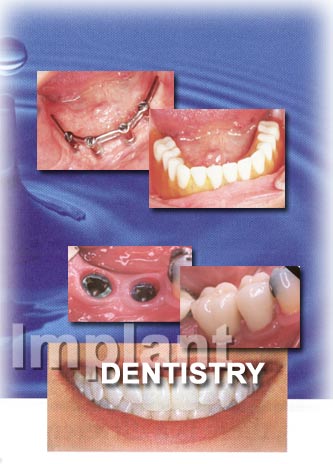
|

• Implant Case Studies
|

All Implant Restorations Shown Were Placed
By Dr. Barry F. McArdle, DMD
Dental implants are the closest option to your natural ones that dentistry has to offer for any teeth that you may be missing. Dental implants are exceptionally versatile. They can be used in various situations from replacing any single tooth you may be missing by supporting a crown to replacing all of your teeth on a given arch with multiple implant-supported crowns or a full denture anchored by several implants connected by a bar.
If Dr. McArdle determines that dental implant placement is an appropriate choice in your particular case, he will formulate a treatment plan for you that includes implants and refer you to a surgeon who will deliver the implants for you. After a suitable healing period, Dr. McArdle can then restore the implant(s) with either crowns, bridgework or full denture prosthetics. Dr. McArdle believes that certain specialists, oral surgeons or periodontists (gum specialists), are most qualified to place implants.
Although it may sound rather involved, implant placement has become remarkably routine. After the oral surgeon or periodontist has evaluated the areas of your jawbone that have been treatment planned as implant sites, the number and type of implants to be used will be selected. At this point, if the jawbone where the implant(s) are contemplated is lacking in bulk, an appointment to enhance the quantity of bone will first be scheduled. At this appointment either a natural calcified or synthetic glass material will be added to the proposed site of implantation to build up the available area for implant insertion.
This procedure is termed either bone grafting or sinus augmentation and commonly is needed on the lower jaw at the anterior region where bone shrinkage after tooth loss is most severe or in the posterior region of the upper jaw where the position of the sinuses on either side of your nose (your maxillary sinuses) can leave the bone very porous. If an implant is planned to be placed into a fresh extraction site and grafting is necessary, it will be performed around the implant immediately after insertion. This type of implanting is done in limited cases only after careful consideration. In many cases your implant site(s) will be sufficiently ample as to need no enlargement.
Once implant placement has been achieved, a healing period is needed during which your jawbone forms around the implant(s) much like cement setting about a flagpole. This process is termed osseointegration and its length depends on factors such as the implant system used, the quality of your jawbone at the implant site and the type of prosthetics to be anchored by the implant(s).
After osseointegration, your implant(s) can be restored with definitive crowns, bridgework or full dentures to reestablish function and improve esthetics. Dr. McArdle is responsible for all phases of implant restoration from the fabrication of guides to help the surgeon ascertain the best angle at which to situate your implant(s) for the finest restorative result through design and rendering of the final restoration(s). Most patients who have undergone implant dentistry find dental implants to be indistinguishable from their natural teeth and thus the most desirable treatment alternative for the replacement of their missing teeth. Dr. McArdle can answer any questions you may have about dental implants.
The contents of this website are provided by Dr. McArdle to furnish you with general information for educational purposes only. Under no circumstances are they intended to replace the personal advice and treatment that you would receive in consultation with a dentist or other health care professional. |


